1994 CHEVROLET CORVETTE flat tire
[x] Cancel search: flat tirePage 168 of 274
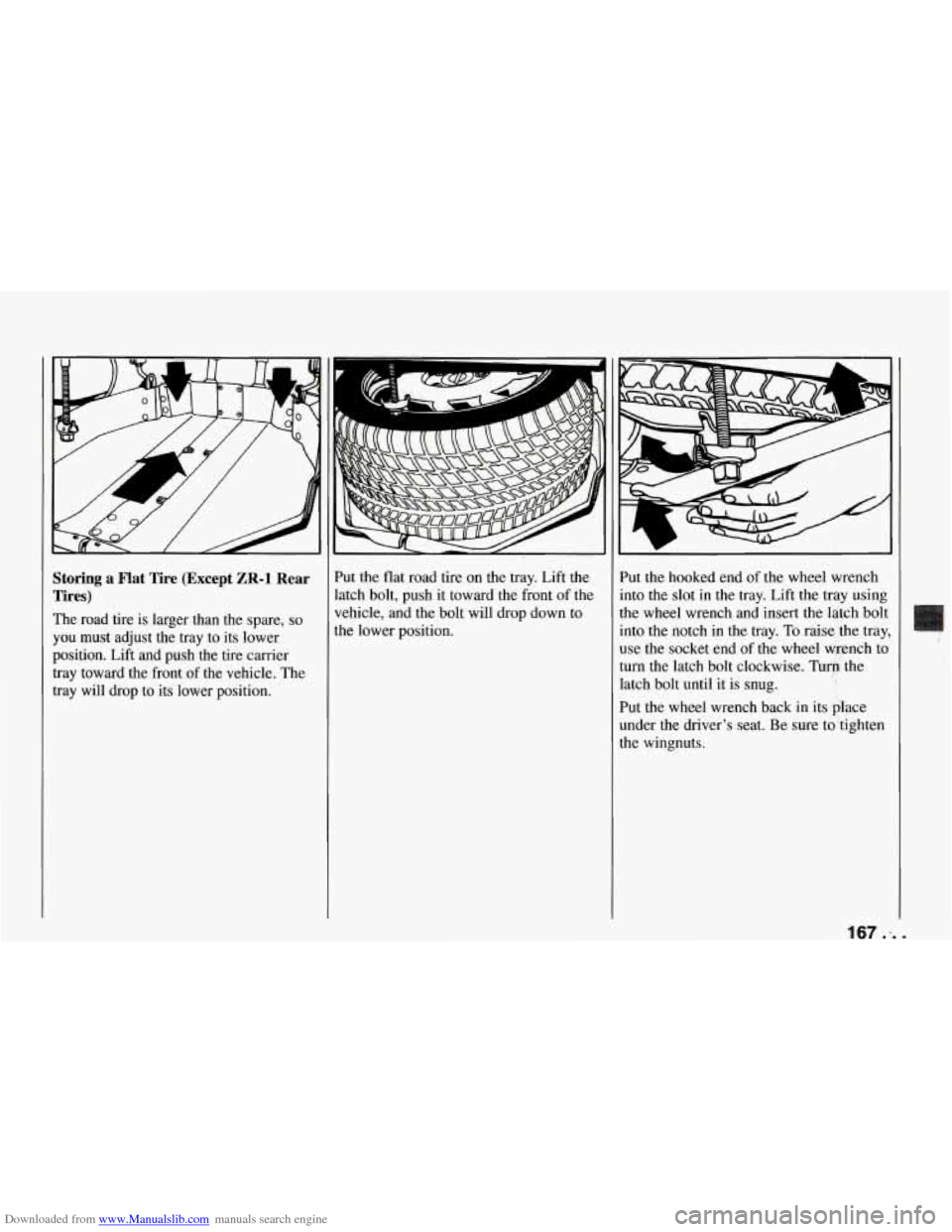
Downloaded from www.Manualslib.com manuals search engine Storing a Flat Tire (Except ZR-1 Rear
Tires)
The road tire is larger than the spare, so
you must adjust the tray to its lower
position. Lift and push the tire carrier
tray toward the front of the vehicle. The
tray will drop to its lower position. Put
the flat road tire
on the tray. Lift the
latch bolt, push it toward the front
of the
vehicle, and the bolt will drop down to
the lower position. Put the
hooked end of the wheel wrench
into the slot in the tray. Lift the tray using
the wheel wrench and insert the latch bolt
into the notch
in the tray. To raise the tray,
use the socket end of the wheel wrench to
turn the latch bolt clockwise. Turn the
latch bolt until it is snug.
Put the wheel wrench back in its place
under the driver's seat. Be sure to tighten
the wingnuts.
167 :. .
Page 169 of 274
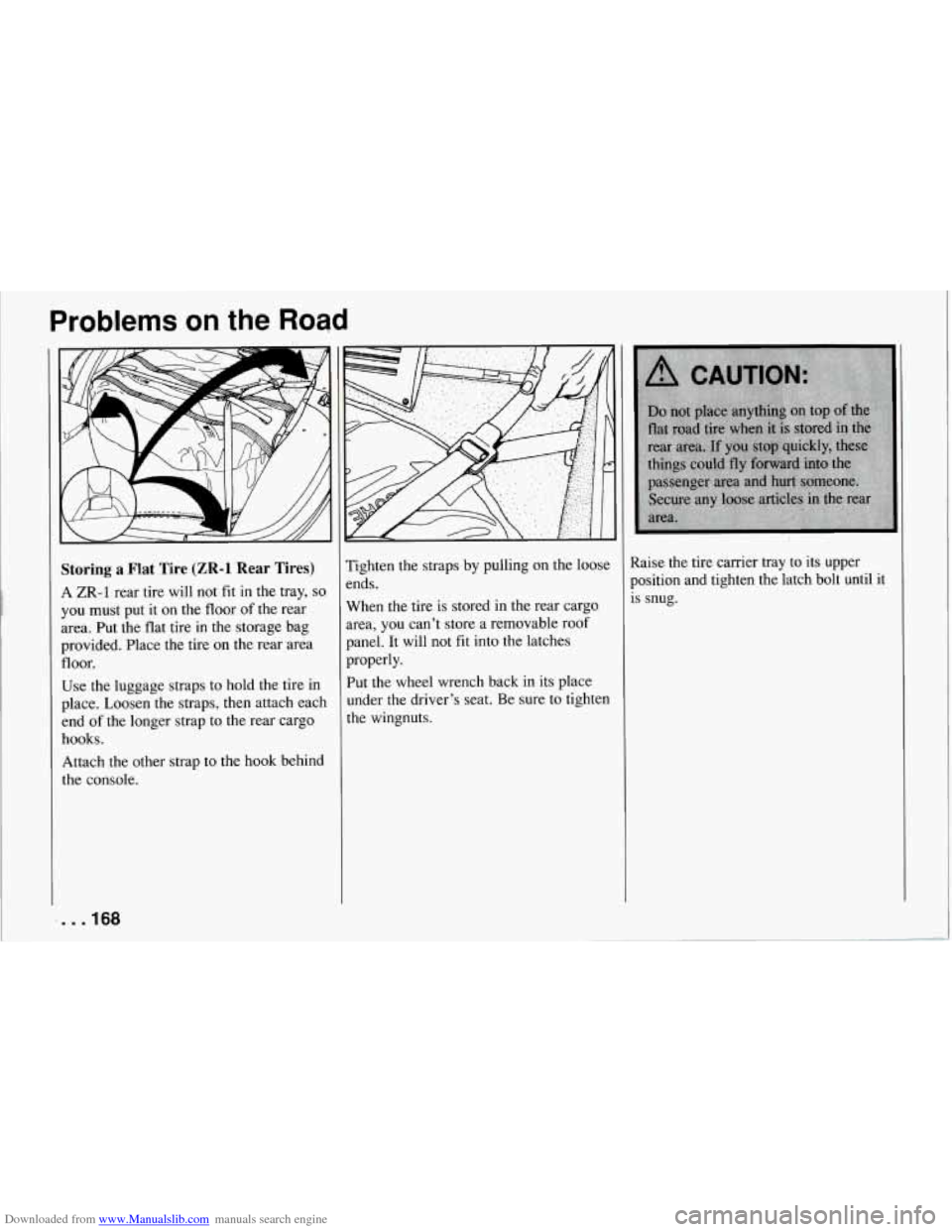
Downloaded from www.Manualslib.com manuals search engine Problems on the Road
Storing a Flat Tire (ZR-1 Rear Tires)
A ZR-1 rear tire will not fit in the tray, so
you must put it on the floor of the rear
area. Put the flat tire
in the storage bag
provided. Place the tire on the rear area
floor.
Use the luggage straps to hold the tire in
place. Loosen the straps, then attach each
end of the longer strap to the rear cargo
hooks.
Attach the other strap to the hook behind
the console. righten
the straps by pulling
on the loose
ends.
When the tire is stored in the rear cargo
area, you can’t store a removable roof
panel. It will not
fit into the latches
properly.
Put the wheel wrench back in its place
under
the driver’s seat. Be sure to tighten
the wingnuts. Raise the
tire carrier tray to its upper
position and tighten the latch bolt until
it
is snug.
Page 170 of 274

Downloaded from www.Manualslib.com manuals search engine Compact Spare Tire
Although the compact spare was fully
inflated when your vehicle was new, it
can lose air after a time. Check the
inflation pressure regularly. It should be
60 psi (420 kPa). After installing the
compact spare on your vehicle, you
should stop as soon as possible and make
sure your spare tire is correctly inflated.
The compact spare is made to perform
well at posted speed limits for distances
up to
3,000 miles (5 000 km), so you can
finish your trip and have your full-size
tire repaired or replaced where you want.
Of course, it’s best to replace your spare
with a full-size tire as soon as you can.
Your spare will last longer and be in
good shape in case you need it again.
-
NOTICE:
Don’t take your compact spare
through an automatic car wash with
guide rails. The compact spare can
get caught on the rails. That can
damage the tire and wheel, and
maybe other parts
of your vehicle.
Don’t use your compact spare on some
other vehicle.
And don’t
mix your compact spare or
wheel with other wheels
or tires. They
won’t
fit. Keep your spare and its wheel
together.
NOTICE:
Tire chains won’t fit your compact
spare. Using them will damage
your vehicle and destroy the chains
too. Don’t use tire chains on your
compact spare.
If You’re Stuck: In
Sand, Mud, Ice or
Snow
What you don’t want to do when your
vehicle is stuck is to spin your wheels.
The method known as “rocking” can help
you get out when you’re stuck, but .you
must use caution.
169 ...
Page 203 of 274
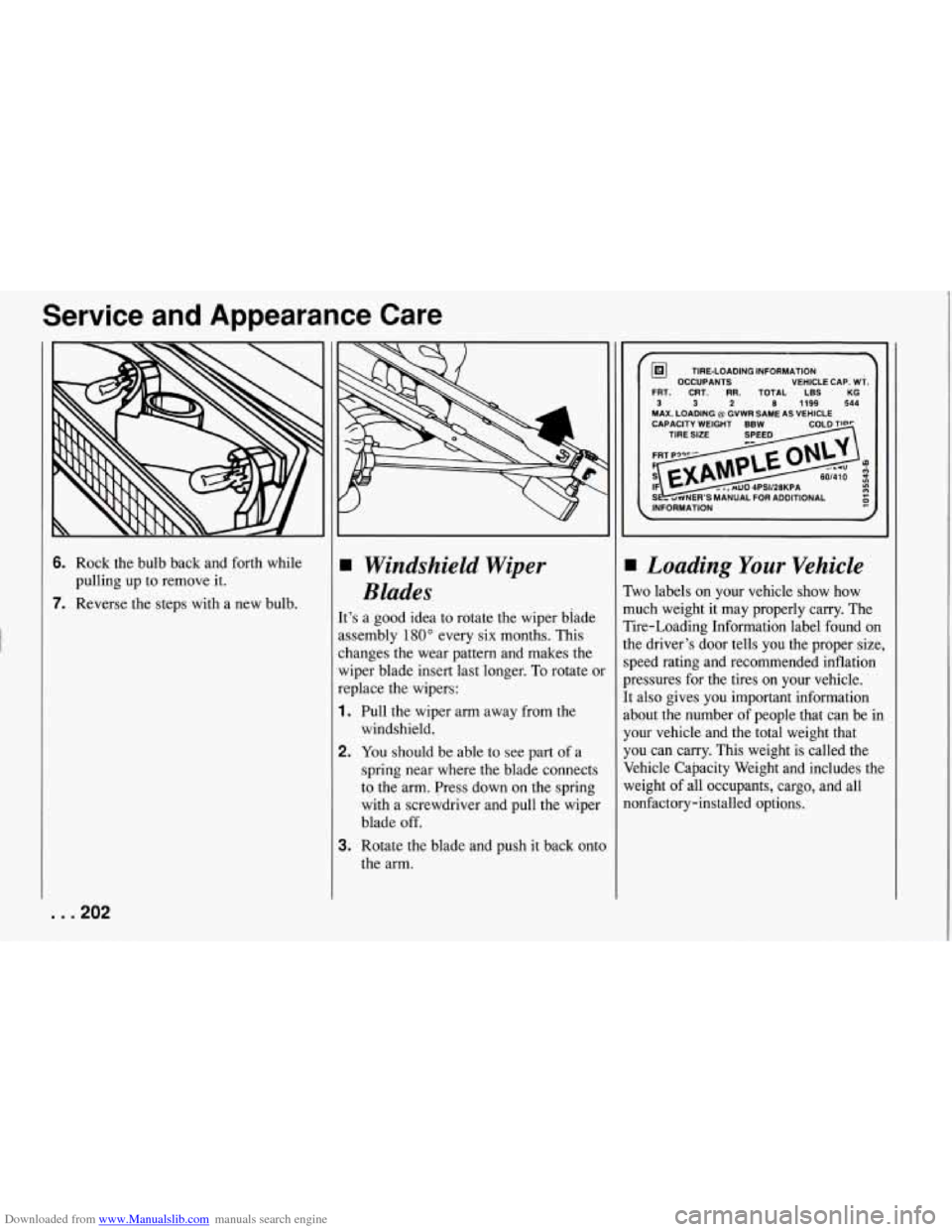
Downloaded from www.Manualslib.com manuals search engine Service and Appearance Care
6. Rock the bulb back and forth while
pulling up to remove it.
7. Reverse the steps with a new bulb.
. . ,202
Windshield Wiper
Blades
It's a good idea to rotate the wiper blade
assembly
180" every six months. This
changes the wear pattern and makes the
wiper blade insert last longer.
To rotate 01
replace the wipers:
1.
2.
3.
Pull the wiper arm away from the
windshield.
You should be able to see part of a
spring near where the blade connects
to the arm. Press down on the spring
with a screwdriver and pull the wiper
blade
off.
Rotate the blade and push it back ontc
the arm.
TIRE-LOADING INFORMATION
FRT. CRT.
RR. TOTAL LBS KG 3 3 2 MAX. LOADING @ GVWR SAME AS VEHICLE a 1199 544
CAPACITY WEIGHT BBW OCCUPANTS VEHICLE CAP.
wi.
TIRE SIZE
60/410
3 9
INFORMATION 0 F
/
I Loading Your Vehicle
Two labels on your vehicle show how
nuch weight it may properly carry. The
rire-Loading Information label found on
he driver's door tells you the proper size,
'peed rating and recommended inflation
n-essures for the tires on your vehicle.
t also gives you important information
ibout the number
of people that can be in
Tour vehicle and the total weight that
TOU can carry. This weight is called the
iehicle Cabacity Weight and includes the
weight of all occupants, cargo, and all
lonfactory-installed options.
Page 206 of 274
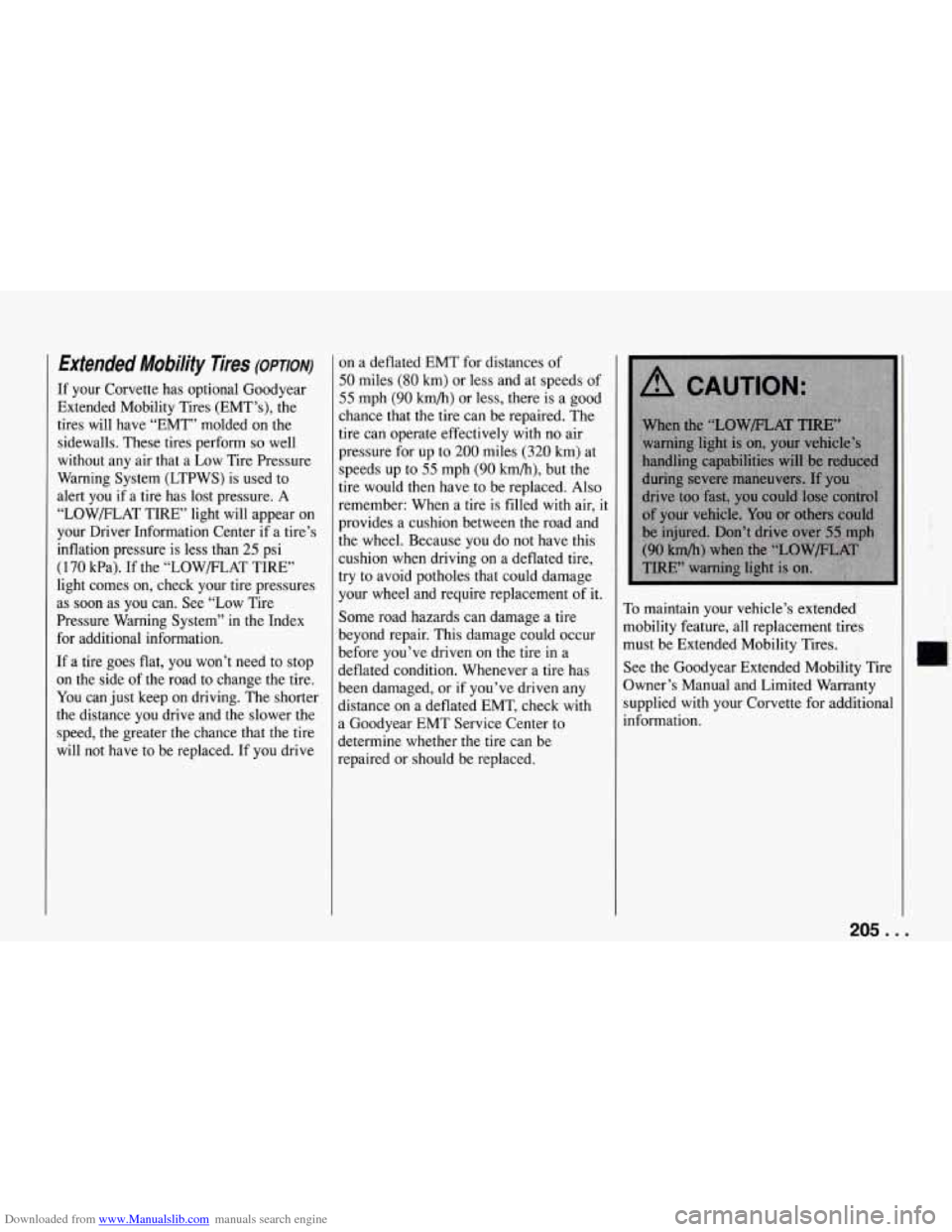
Downloaded from www.Manualslib.com manuals search engine Extended Mobility Tires (omoiv)
If your Corvette has optional Goodyear
Extended Mobility Tires (EMT’s), the tires will have “EMT” molded on the
sidewalls. These tires perform
so well
without any air that a Low Tire Pressure
Warning System (LTPWS)
is used to
alert you if a tire has lost pressure.
A
“LOWELAT TIRE” light will appear on
your Driver Information Center if a tire’s
inflation pressure is less than
25 psi
(1 70 kPa). If the “LOWELAT TIRE”
light comes on, check your tire pressures
as soon as you can. See “Low Tire
Pressure Warning System” in
the Index
for additional information.
If a tire goes flat, you won’t need to stop
on the side of the road to change the tire.
You can just keep on driving. The shorter
the distance you drive and the slower the
speed, the greater the chance that the tire
will not have to be replaced. If you drive on
a deflated EMT for distances
of
50 miles (80 km) or less and at speeds of
55 mph (90 km/h) or less, there is a good
chance that the tire can be repaired. The
tire can operate effectively with no air
pressure for up to
200 miles (320 km) at
speeds up to
55 mph (90 km/h), but the
tire would then have to be replaced. Also
remember: When a tire is filled with air, it
provides a cushion between the road and
the wheel. Because you do not have this
cushion when driving on a deflated tire,
try to avoid potholes that could damage
your wheel and require replacement of it.
Some road hazards can damage a tire
beyond repair. This damage could occur
before you’ve driven on the tire in a
deflated condition. Whenever a tire has
been damaged, or if you’ve driven any
distance on a deflated EMT, check with
a Goodyear EMT Service Center to
determine whether the tire can be
repaired or should be replaced. To
maintain your vehicle’s extended
mobility feature, all replacement tires
must be Extended Mobility Tires.
See the Goodyear Extended Mobility Tire
Owner’s Manual and Limited Warranty
supplied with your Corvette for additional
information.
205. .
Page 207 of 274

Downloaded from www.Manualslib.com manuals search engine Service and Appearance Care
Inflation - Tire Pressure
The Tire-Loading Information label which is on the driver’s door shows the correct
inflation pressures for your tires, when they’re cold. “Cold” means your vehicle has
been sitting for at least three hours or driven no more than a mile.
For competitive driving or high-speed driving (over
150 mph or 240 krn/h), make
sure your tires are inflated to
35 psi (240 kPa). When you end this type of driving,
reduce the “cold” inflation pressures (if necessary) to those listed
on the
Tire-Loading Information label.
NOTICE:
Don’t let anyone tell you that underinflation or overinflation is all right. It’s not.
If your tires don’t have enough air (underinflation) you can get:
0 Too much flexing
0 Too much heat
0 Tire overloading
0 Bad wear
0 Bad handling
Bad fuel economy.
If your tires have too much air (overinflation), you can get:
Unusual wear
Bad handling
0 Rough ride
Needless damage from road hazards.
When to Check: Check your tires
mce
a month or more. Don’t forget
your compact spare tire. It should be at
50 psi (420 Wa).
How to Check: Use a good quality
pocket-type gauge to check tire
pressure. Simply looking at the tires
will not tell you the pressure,
=specially if you have radial tires
-
which may look properly inflated even
if they’re underinflated.
Lf your tires have valve caps, be sure to
put them back on. They help prevent
leaks by keeping out dirt and moisture.
Tire Rotation
I’he tires on your Corvette are
lirectional, asymmetrical, and are
different sizes front to rear. Due to this,
your tires should not be rotated. Each
tire and wheel should be used only in
the position it is in.
. . .206
Page 209 of 274

Downloaded from www.Manualslib.com manuals search engine Service and Appearance Care
on a specified government test course. For
example, a tire graded 150 would wear
one and a half
(1 1/2) times as well on the
government course as a tire graded
100.
The relative performance of tires depends
upon the actual conditions of their use,
however, and may depart significantly
from the norm due to variations in driving
habits, service practices and differences in
road characteristics and climate.
Traction - A, B, C
The traction grades, from highest to
iowest are:
A, B, and C. They represent
the tire’s ability to stop on wet pavement
as measured under controlled conditions
on specified government test surfaces of
asphalt and concrete.
A tire marked C
may have poor traction performance.
Warning: The traction grade assigned
to this tire is based on braking
(straight-ahead) traction tests and does
not include cornering (turning) traction.
Temperature - A, B, C
The temperature grades are A (the
highest),
B, and C, representing the tire’s
resistance to the generation of heat and its
ability to dissipate heat when tested under
controlled conditions on a specified
. . .208
indoor laboratory test wheel. Sustained
high temperature can cause the material
of the tire to degenerate and reduce tire
life, and excessive temperature can lead to
sudden tire failure. The grade C
corresponds to a level
of performance
which all passenger car tires must meet
under the Federal Motor Vehicle Safety
Standard
No. 109. Grades B and A
represent higher levels of performance on
the laboratory test wheel than the
minimum required by law.
Warning: The temperature grade for
this tire is established for a tire that is
properly inflated and not overloaded.
Excessive speed, underinflation, or
excessive loading, either separately or
in combination, can cause heat buiidup
and possible tire failure.
These grades are molded on the sidewalls
of passenger car tires.
While the tires available as standard or
optional equipment on General Motors
vehicles may vary with respect to these
grades, all such tires meet General Motors
performance standards and have been
approved for use on General Motors
vehicles. All passenger type
(P Metric)
tires must conform to Federal safety
requirements in addition to these grades.
Wheel Alignment and Tire Balance
The wheels on your vehicle were aligned
and balanced carefully at the factory to
give you the longest tire life and best
overall performance.
In most cases, you will not need to have
your wheels aligned again. However, if
you notice unusual tire wear or your
vehicle pulling one way or
the other, the
alignment may need to be reset. If you
notice your vehicle vibrating when
driving on a smooth road, your wheels may need to be rebalanced.
Wheel- Replacement - . -
Replace any wheel that is bent, cracked or
badly rusted. If wheel nuts keep coming
loose, the wheel, wheel bolts, and wheel
nuts should be replaced. If the wheel
leaks air, replace it (except some
aluminum wheels, which can sometimes
be repaired). See your Chevrolet dealer
if any of these conditions exist.
Your dealer will know the kind of wheel
you need.
Each new wheel should have the same
load carrying capacity, diameter, width,
offset, and be mounted
the same way as
the one it replaces.
Page 231 of 274
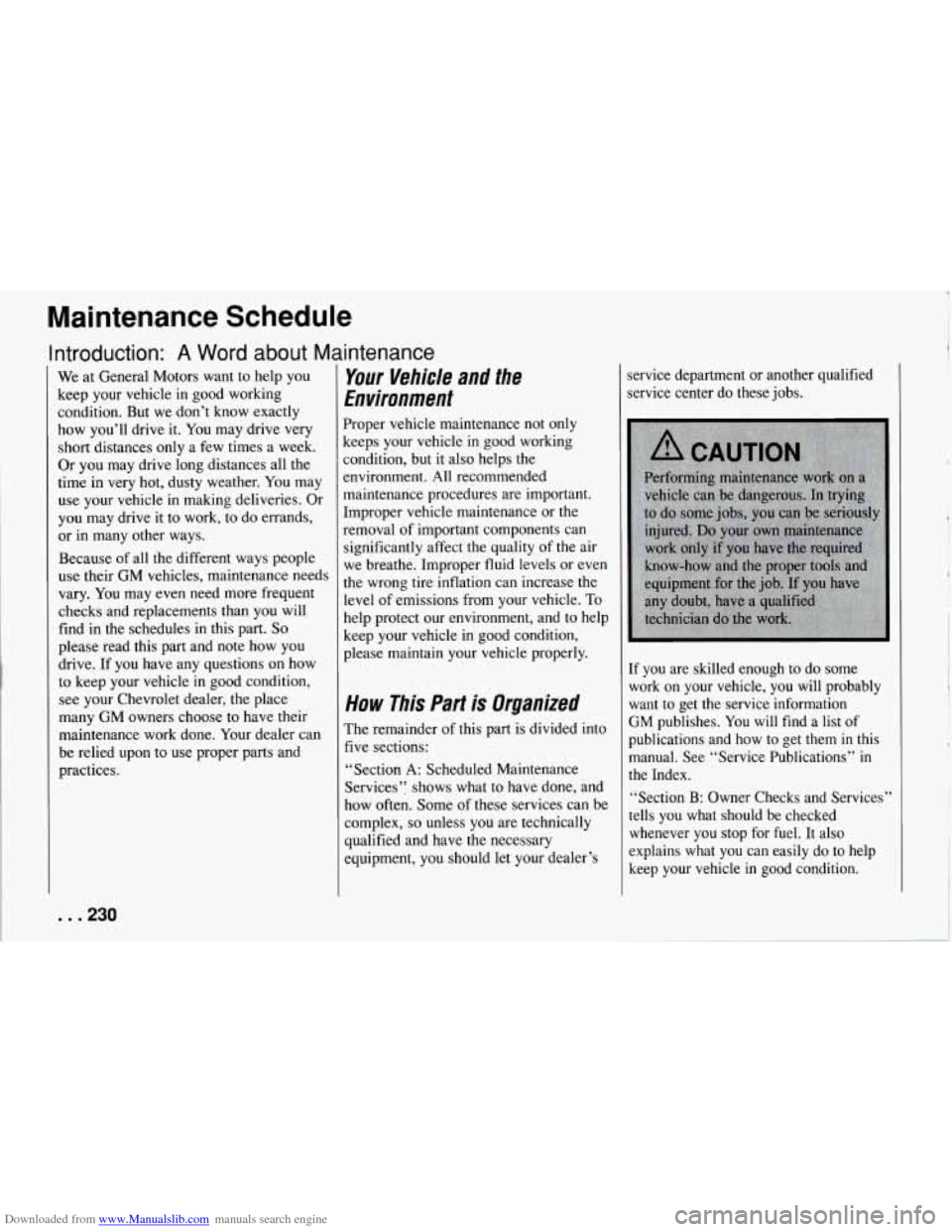
Downloaded from www.Manualslib.com manuals search engine Maintenance Schedule
Introduction: A Word about Maintenance
We at General Motors want to help you
keep your vehicle in good working
condition. But we don’t know exactly
how you’ll drive it. You may drive very
short distances only a few times a week.
Or you may drive long distances all the
time in very hot, dusty weather.
You may
use your vehicle in making deliveries. Or
you may drive it to work, to do errands,
or
in many other ways.
Because of all the different ways people
use their GM vehicles, maintenance needs
vary. You may even need more frequent
checks and replacements than you will
find in the schedules in this part.
So
please read this part and note how you
drive. If you have any questions on how
to keep your vehicle in good condition,
see your Chevrolet dealer, the place
many GM owners choose to have their
maintenance work done. Your dealer can
be relied upon to use proper parts and
practices.
Your Vehicle and I
Environment the
Proper vehicle maintenance not only
keeps your vehicle in good working
condition,
but it also helps the
environment. All recommended
maintenance procedures are important.
Improper vehicle maintenance or the
removal of important components can
significantly affect the quality of the air
we breathe. Improper fluid levels or even
the wrong tire inflation can increase the
level of emissions from your vehicle. To
help protect our environment, and to help
keep your vehicle in good condition,
please maintain your vehicle properly.
How This Part is Organized
The remainder of this part is divided into
five sections:
“Section
A: Scheduled Maintenance
Services’: shows what to have done, and
how often. Some of these services can be
complex,
so unless you are technically
qualified and have the necessary
equipment, you should let your dealer’s lified
service department or another
qua
service center do these jobs.
If you are skilled enough to do some
work on your vehicle, you will probably
want to get the service information
GM publishes. You will find a list of
publications and how to get them in this
manual. See “Service Publications”
in
the Index.
“Section B: Owner Checks and Services’’
tells you what should be checked whenever you stop for fuel. It also
explains what you can easily do to help
keep your vehicle in good condition.
1
. . .230